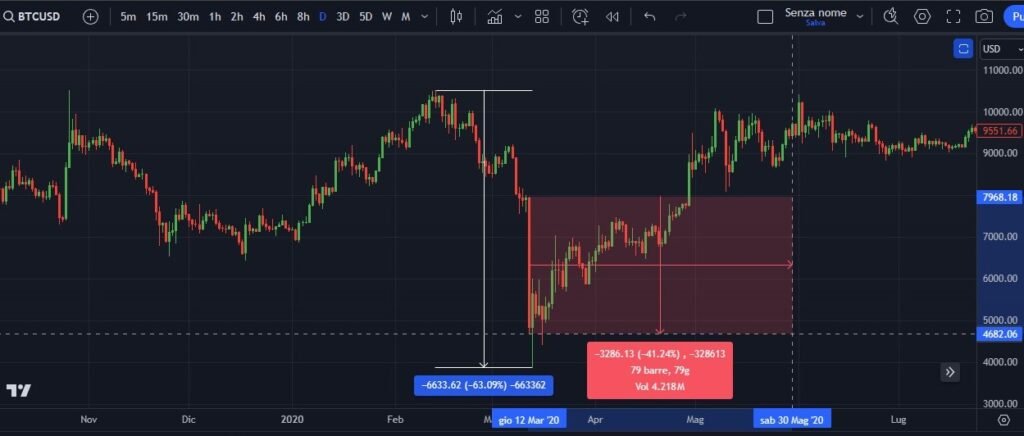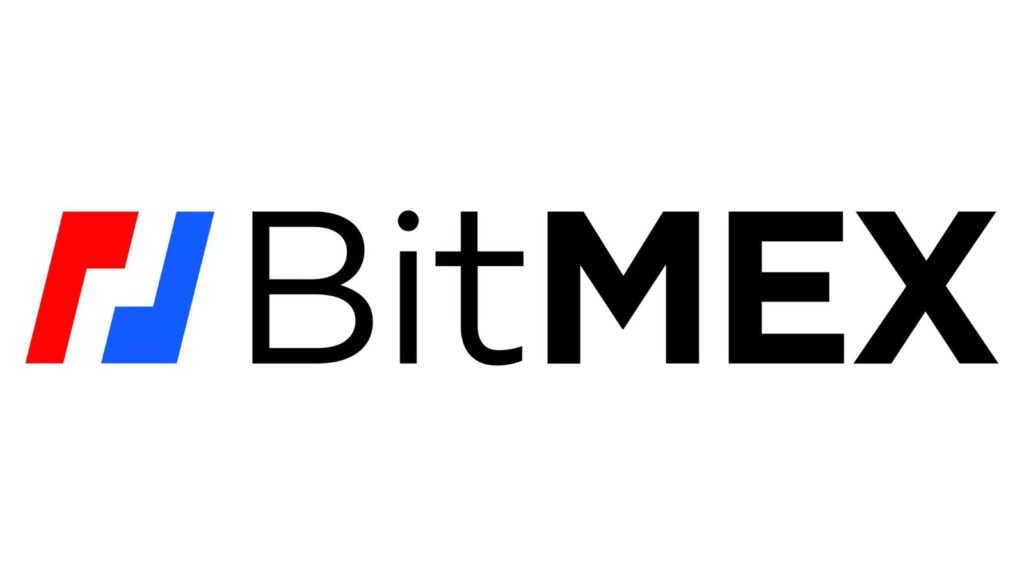This lecture is the first in a series of lectures that are historical in nature. Therefore, the goal will be to acquaint readers with events that happened in the past in traditional finance that have recently recurred in very similar ways in the crypto sector. Below we analyze the 1987 “Black Monday” stock market crash and the 2020 “Covid Crash” to find interesting similarities and differences.
TRADITIONAL FINANCE
MAGNITUDE OF THE CRASH
The SP500 stock index recorded -35% from the high that occurred in August 25, 1987 to the low on October 20 of the same year, but the most striking event happened on Monday, October 19, in which it recorded -20% in a single day. That of Black Monday was the largest collapse in both percentage swing and speed since that of 1929, when the Great Depression began.
Below is a chart of SPX, a well-known ETF that replicates the performance of the SP500 stock index

THE MAIN CAUSES OF THE CRASH
Certainly a key factor consisted in the reduction of circulating liquidity in global financial markets. A valid hypothesis is found in the reduction of internal liquidity in the German and Japanese economic systems due to fears of rising inflation: this caused a worldwide rise in interest rates and instability in currency exchange rates.
At some point, seemingly isolated but actually interrelated events began to occur, for example, the collapse of the Japanese bond market in September 1987, which weakened the U.S. bond market. Another example is found in the disparity, which had been building since late 1986 and widening month after month, between bond and stock prices, and generally that kind of divergence leads to high instability in the markets; the weakness of the dollar was another important factor.
Throwing gasoline on the fire was Alan Greenspan, Chairman of the Federal Reserve
According to economic theory, the U.S . should have raised interest rates, but instead James Baker, U.S. Treasury secretary, lobbied the German central bank for them to lower interest rates. The U.S. authorities and government decided not to raise interest rates because they feared an economic recession, so they let the dollar depreciate.
As anticipated earlier, U.S. stock indexes recorded -20 percent in a single day, but stock markets in London, Switzerland and Hong Kong fared even worse. While the other stock markets a continued to reach new lows in the following days, the New York market did not exceed the lows set in the initial selling climax.
Theonly stock market that avoided a crash was the Japanese market, as the Japanese authorities did everything they could to stop the panic: they even allowed the country’s four largest brokers to be licensed to operate on their own account, which means giving them the ability to manipulate the market.

INTERNAL MARKET MECHANISMS
Having understood why the crash occurred, let’s turn to how that event so devastating that the crisis of ’29 resurfaced in people’s minds happened. Basically, the two main problems consisted of program trading patterns (program trading), which followed a “portfolio insurance” strategy, and generalized panic.
While generalized panic is a reaction found in many other situations of extreme volatility, portfolio insurance constituted a feature of the 1987 crash. In those days, portfolio insurance consisted of a hedging strategy designed to limit the losses that an investor might suffer from a drop in a stock index without having to sell the securities in the portfolio.
This strategy involved selling futures contracts
What then happened was the triggering of a vicious cycle (a veritable “death spiral“), which would have been unstoppable without outside intervention. The dynamic was as follows: the stock index began to fall, and trading programs gradually opened short
CENTRAL BANKS’ REACTION
Only the quick reaction of Alan Greenspan of the Federal Reserve Bank (Fed), who immediately cut rates and provided liquidity to the financial markets, allowed prices to reduce volatility, that is, to slow the speed of price declines, in the following weeks.
Following Black Monday,“circuit breakers,” i.e., mechanisms that suspended trading in the event of excessive fluctuations in the indices, were implemented to prevent further collapses. This tool would allow markets to calm down on future occasions of high danger, as traders would have time to process information and make more considered decisions.
Because of the global repercussions of the crash, central banks and financial authorities around the world cooperated to stabilize global markets by sharing information and coordinating economic and monetary policies.
Those interventions helped curb the collapse of the SP500 stock index and gradually restored confidence in the financial system. Let us now turn to the crypto sector.
CRYPTO SECTOR
THE COVID-CRASH
In late 2019 and early 2020, the pandemic began to spread globally, and the shutdown of the world’s major economies, a measure chosen by governments to counter the virus, generated panic in financial markets.
Thursday, March 12, 2020 was the most catastrophic day in the history of Bitcoin’s price as it lost -40%, going from $7950 to $4675; if the losses of the following day are also added, then it comes to a total of -51%, with a low at $3880.
Prices vary by exchange

BITMEX UNDER INDICTMENT
Investors and traders fell into panic because of the official recognition of a global pandemic and the total shutdown of the economy (lockdown) and the obligation of governments of countries around the world to stay at home. In the cryptocurrency sector, this emotionality resulted in a massive sale of bitcoins by pare of market participants in centralized exchanges in exchange for dollars, as no one at the time had the faintest idea what would happen.
This caused a rapid decline in price, which in turn caused a huge cascade of liquidations of perpetual long futures contracts, increasing the bearish pressure (death spiral) even more. BitMEX’s once popular exchange recorded liquidations of $750 million in bitcoin within minutes.
On March 13, the exchange was shut down for “maintenance” by Arthur Hayes, CEO of BitMEX, and other then-popular exchanges such as Deribit, Gemini, Huobi, Deribit, and Bithumb also experienced technical difficulties.
Some pointed out that traditional exchanges also suspended trading during massive declines, so it was unclear why one should expect a different approach from centralized exchanges in the crypto sector, but a great many were still disappointed. BitMEX was placed at the center of a controversy because of the outage, which lasted about 25 minutes. During that downtime, rumors spread among crypto traders that someone was conducting illegal activities behind the scenes.

BITMEX’S DEFENSE
To allay doubts, BitMEX ‘s public relations team issued a tweet in which they wrote that the company had learned of a hardware problem with their cloud service provider that had caused a delay in BitMEX’s systems. Similar justifications, such as a DDoS attack
To better understand the issue, Cointelegraph
When BitMEX’s spokesperson was asked if the exchange “pulled the plug” on its trading services for fear that its settlement engine might collapse XBTUSD’s order book
Finally, on March 16, Arthur Hayes intervened on Twitter to assure platform customers that he and the team would be committed to answering questions transparently and completely.
THE SHUTDOWN OF BITMEX’S LIQUIDATION ENGINE
The “liquidationengine” (literally translated as “liquidation engine”) is nothing more than is a risk management computer program that cryptocurrency exchanges employ to avoid significant losses from highly leveraged positions in derivatives trading.
Liquidations of BTC’s long positions on BitMEX were generating a spread
Essentially, the real reason for shutting down the entire exchange, thus including the liquidation engine, lay in the fact that if it remained open, the whales who were shorting Bitcoin could have pushed the price to zero through BitMEX’s automatic liquidation system.
Whales are understood to mean investors and traders (institutional and non-institutional) who operate with large amounts of capital (millions and billions of dollars), while retail investors and traders are used to smaller amounts of money (thousands and hundreds of thousands of dollars) that hardly ever affect market prices.
It is very difficult to think that those whales had the intention to collapse the price of Bitcoin to zero; they were probably hedging shorts on their spot positions.
CLARIFICATIONS ON BITMEX AND ARTHUR HAYES
Some pointed out that BitMEX was well known for its “order submission errors.” In other words–according to industry experts–it meant that Hayes’ exchange was routinely faced with data overloads that caused its system to malfunction, as well as failure to execute client orders. Essentially, the trading platform was using outdated technology that was therefore unable to function properly under certain circumstances. As Bitcoin’s price recovered from the Covid-crash of March 2020 and reached a new all-time high later that year, BitMEX CEO Arthur Hayes was sentenced to 2 years probation for money laundering.
COMPARING EPISODES
Thirty-three years later, financial markets have experienced two unlikely, unpredictable events with potentially catastrophic consequences: referred to in the jargon as “Black Swans.” Only the intervention of agents outside the markets managed to contain the damage and reverse the downward spiral that was generated on Black Monday 1987 in the SP500 index and March 12-13 2020 in the price of Bitcoin: Alan Greenspan of the Federal Reserve in the case of traditional finance; Arthur Hayes of the BitMEX exchange in the case of the crypto sector. Finally, without that kind of intervention one can speculate that-in the first case-the entire global finance might have collapsed and the real economy would probably have gone into recession for many years to come.
In the second case, if the price of Bitcoin had gone to zero on the BitMEX exchange, presumably the largest exchange in the industry would have gone out of business, as all users would have withdrawn their capital; moreover, the prices of altcoins
Of course, these are speculations about how history would have gone if there had not been the timely interventions mentioned above, however, fortunately the bearish hell-spiral was crushed in both cases. History does not repeat itself, but it does rhyme.

